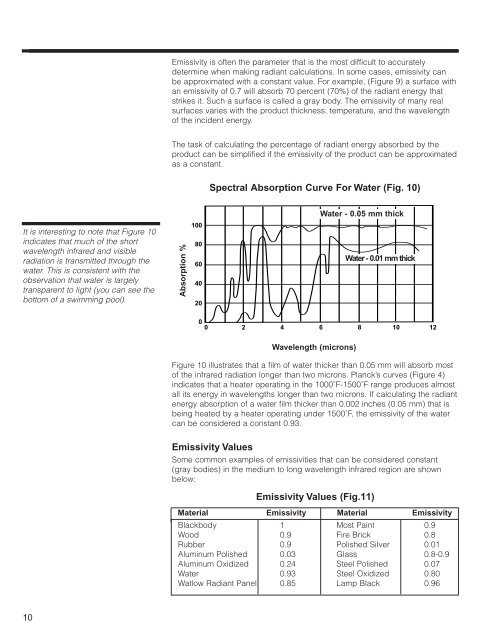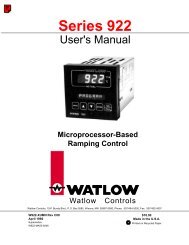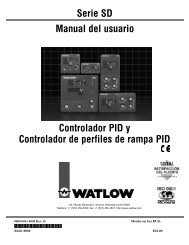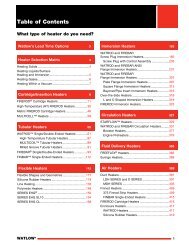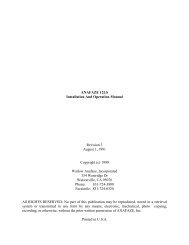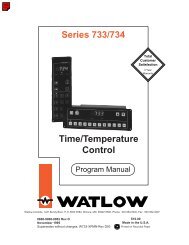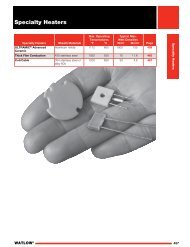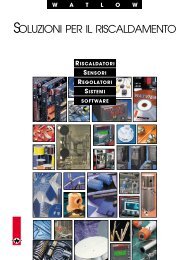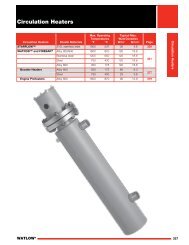RADIANT HEATING WITH INFRARED - Watlow
RADIANT HEATING WITH INFRARED - Watlow
RADIANT HEATING WITH INFRARED - Watlow
You also want an ePaper? Increase the reach of your titles
YUMPU automatically turns print PDFs into web optimized ePapers that Google loves.
It is interesting to note that Figure 10<br />
indicates that much of the short<br />
wavelength infrared and visible<br />
radiation is transmitted through the<br />
water. This is consistent with the<br />
observation that water is largely<br />
transparent to light (you can see the<br />
bottom of a swimming pool).<br />
10<br />
Emissivity is often the parameter that is the most difficult to accurately<br />
determine when making radiant calculations. In some cases, emissivity can<br />
be approximated with a constant value. For example, (Figure 9) a surface with<br />
an emissivity of 0.7 will absorb 70 percent (70%) of the radiant energy that<br />
strikes it. Such a surface is called a gray body. The emissivity of many real<br />
surfaces varies with the product thickness, temperature, and the wavelength<br />
of the incident energy.<br />
The task of calculating the percentage of radiant energy absorbed by the<br />
product can be simplified if the emissivity of the product can be approximated<br />
as a constant.<br />
Absorption %<br />
100<br />
80<br />
60<br />
40<br />
20<br />
0<br />
0<br />
Spectral Absorption Curve For Water (Fig. 10)<br />
2<br />
4<br />
Figure 10 illustrates that a film of water thicker than 0.05 mm will absorb most<br />
of the infrared radiation longer than two microns. Planck’s curves (Figure 4)<br />
indicates that a heater operating in the 1000˚F-1500˚F range produces almost<br />
all its energy in wavelengths longer than two microns. If calculating the radiant<br />
energy absorption of a water film thicker than 0.002 inches (0.05 mm) that is<br />
being heated by a heater operating under 1500˚F, the emissivity of the water<br />
can be considered a constant 0.93.<br />
Emissivity Values<br />
Some common examples of emissivities that can be considered constant<br />
(gray bodies) in the medium to long wavelength infrared region are shown<br />
below:<br />
6<br />
Wavelenght (microns)<br />
Wavelength (microns)<br />
Water - 0.05 mm thick<br />
Emissivity Values (Fig.11)<br />
Water - 0.01 mm thick<br />
Material Emissivity Material Emissivity<br />
Blackbody 1 Most Paint 0.9<br />
Wood 0.9 Fire Brick 0.8<br />
Rubber 0.9 Polished Silver 0.01<br />
Aluminum Polished 0.03 Glass 0.8-0.9<br />
Aluminum Oxidized 0.24 Steel Polished 0.07<br />
Water 0.93 Steel Oxidized 0.80<br />
<strong>Watlow</strong> Radiant Panel 0.85 Lamp Black 0.96<br />
8<br />
10<br />
12


